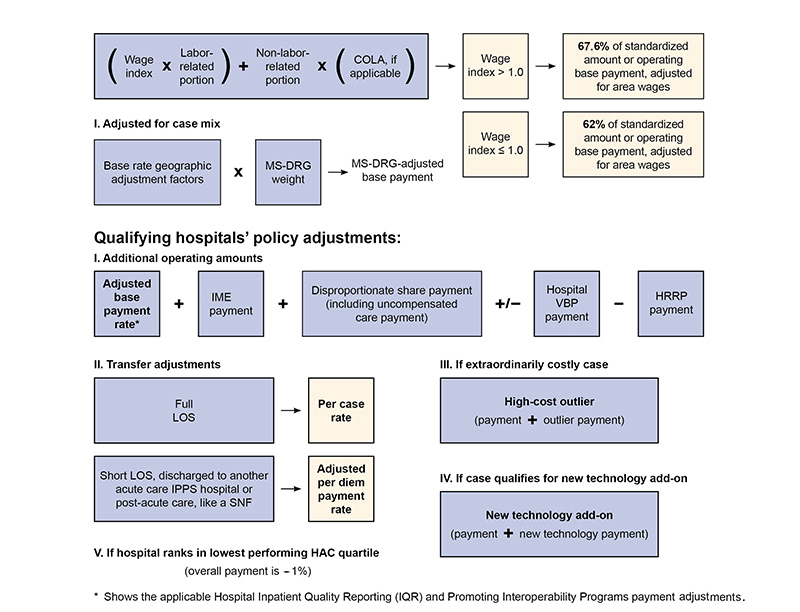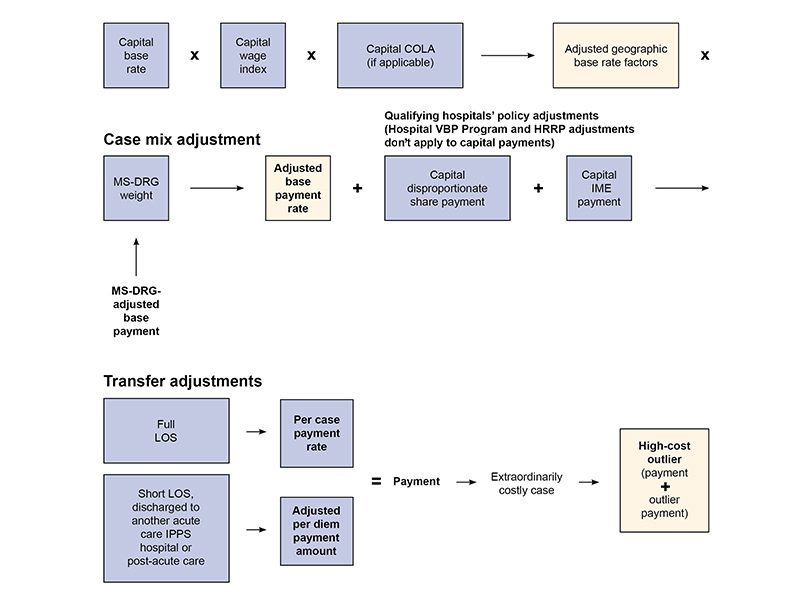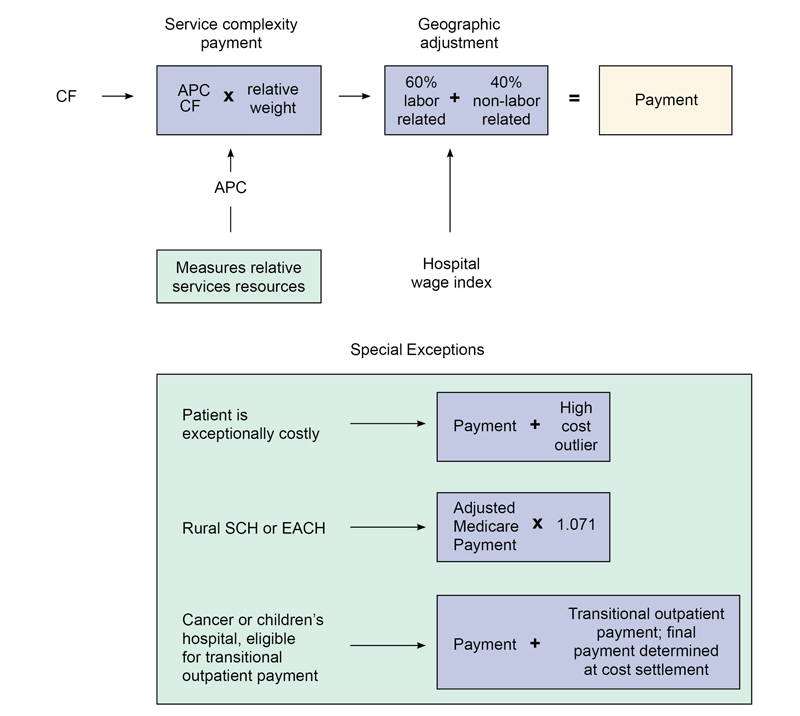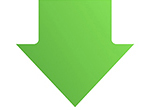CMS makes updates to IPPS payment rates, including updates to base rates, wage indexes, Medicare Severity Diagnosis-Related Group (MS-DRG) definitions and weights, and the outlier fixed-loss amount. We update IPPS base rates annually based on the applicable market basket index and estimates of changes in productivity.
For FY 2025, the increase in IPPS operating payment rates is 2.9% for general acute care hospitals that successfully participate in the Hospital Inpatient Quality Reporting (IQR) Program and are meaningful electronic health record (EHR) users. This reflects a projected FY 2025 IPPS hospital market basket update of 3.4%, reduced by the statutorily required 0.5 percentage point productivity adjustment.
Congress sets the operating rate update by considering the projected increase in the hospital market basket index, which measures the price increases of goods and services hospitals buy to provide patient care.
We pay acute care hospitals an IPPS payment per inpatient case or inpatient discharge.
The admitting hospital, or an entity wholly owned or operated by the admitting hospital, must bill all outpatient diagnostic services and admission-related outpatient non-diagnostic services during the 3 days before admitting the patient to the hospital on the inpatient claim.
Acute care hospitals can’t separately bill Medicare Part B for these services.
We don’t pay an acute care hospital separately for outpatient services provided to a hospice patient if the services are given to palliate or manage a terminal illness and related conditions. The hospice and acute care hospital outpatient services should be provided under arrangements, per 42 CFR 418.24, 418.64, and 418.70. We pay for Part B outpatient services that are unrelated to a hospice enrollee’s terminal illness and related conditions, though these services should be exceptional, unusual, and rare given the comprehensive nature of the services covered under the Medicare hospice benefit. In these rare instances, the acute care hospital bills Part B for the outpatient service and must include condition code 07 on the claim. Review OIG report A-09-23-03024 for more information.
Section 1886(d)(1)(B) of the Social Security Act excludes certain hospitals and hospital units from the IPPS, including:
- Cancer hospitals
- Children’s hospitals
- Extended neoplastic disease care hospitals
- Hospitals located outside the 50 states, the District of Columbia, and Puerto Rico:
- American Samoa
- Guam
- Northern Mariana Islands
- U.S. Virgin Islands
- Inpatient psychiatric facility hospitals and units
- Inpatient rehabilitation facility hospitals and units
- Long-term care hospitals (LTCHs)
- Religious nonmedical health care institutions
Medicare Severity Diagnosis-Related Groups
We assign inpatient hospital discharges to MS-DRGs, which we use to better reflect patients’ severity of illness, complexity of service, and hospital resource consumption. An MS-DRG is defined by a group of similar clinical conditions (diagnoses) requiring similar resource use.
The patient’s principal diagnosis, secondary diagnoses, procedures performed, sex, age, and discharge status determine MS-DRG assignment. We consider up to 25 diagnosis and 25 procedure codes for MS-DRG assignment. We review MS-DRG definitions annually to ensure each group has clinically similar conditions that are expected to require similar amounts of inpatient resources.
If our review demonstrates that subsets of clinically similar cases within an MS-DRG use significantly different resources, we may propose to reassign them to different MS-DRGs with similar resource use or create new MS-DRGs.
The 3 levels of severity in the MS-DRG system based on secondary diagnoses codes are:
- Major Complication or Comorbidity (MCC) — the highest severity level affecting hospital resource consumption
- Complication or Comorbidity (CC) — the next lowest severity level affecting hospital resource consumption
- Non-Complication or Comorbidity (Non-CC) — the lowest severity level, which doesn’t significantly affect illness severity and resource use
MS-DRGs may be subdivided (or split) into 2 or 3 severity levels according to these CC subgroups. Some MS-DRGs aren’t subdivided into severity levels; these are known as base MS-DRGs. There are 773 MS-DRGs for FY 2025.
MS-DRG Relative Weights
We assign a weight to each MS-DRG that reflects the average case cost in that group compared to the average Medicare case cost and use the same MS-DRG weights for operating and capital payment rates.
We annually adjust the MS-DRG weights without affecting overall IPPS payments, based on standardized charges and all IPPS case costs in each MS-DRG. This adjustment includes a 10% cap on decreases in an MS-DRG relative weight from the previous FY. We standardize hospitals’ billed charges to improve comparability by adjusting:
- Charges to remove differences in hospital wage rates across labor markets
- For the size and intensity of the hospital’s resident training activities
- For the number of low-income hospital patients treated
Note: We reduce charges to costs using national average hospital cost ratios to charges for 19 different hospital departments.
Market Condition Adjustments
We adjust the operating and capital rates by an area wage index to reflect differences in local labor market prices. We measure differences in hospital wage rates among labor markets by comparing the average hourly wage (AHW) for hospital workers in each urban or statewide rural area to the national average.
We use the Office of Management and Budget’s Core-Based Statistical Area delineations, with some modifications, to define each labor market area and annually revise the wage index based on IPPS hospital wage data.
If a hospital believes it competes for labor in a different area than its location, it may request geographic reclassification through the Medicare Geographic Classification Review Board (MGCRB).
These policies also apply to the wage index:
- We apply a permanent 5% cap on any decrease to a hospital’s wage index from its wage index in the previous year, regardless of what caused the decline.
- We apply the wage index to the whole capital base rate and raise it to a fractional power, narrowing the geographic variation in wage index values among labor market areas.
- We apply a COLA, reflecting higher supplies and other non-labor resources costs, to the base IPPS operating and capital rates of hospitals in Hawaii and Alaska. We apply the COLA to the non-labor-related portion of the operating base rate and to the whole capital base rate.
Bad Debts
Bad debts are when a patient doesn’t pay their Medicare coinsurance and deductible. We may pay hospital Medicare bad debts at 65% of the allowable amount if they meet all requirements under 42 CFR 413.89.
Providers can collect unpaid patient Medicare cost-sharing amounts unless the:
- State Medicaid agency classifies the patient as categorically or medically needy
- Provider determines the patient is indigent for bad debt purposes
Providers must submit an acceptable cost report with a detailed bad debt listing corresponding to their claimed bad debt amounts.
Direct Graduate Medical Education
We make direct graduate medical education (DGME) payments to teaching hospitals or hospitals that train residents in approved medical allopathic, osteopathic, dental, or podiatry residency programs. These payments are for the approved residency training programs’ direct operating costs.
We pay these separately from the IPPS per discharge payment and generally base DGME payments on the:
- Number of residents a hospital trains
- Hospital’s Medicare patient load (the proportion of Medicare inpatient days to total inpatient days)
Indirect Medical Education
Teaching hospitals or hospitals that train residents in approved medical allopathic, osteopathic, dental, or podiatry residency programs also get an IME adjustment, which reflects the higher indirect patient care costs of teaching hospitals compared to non-teaching hospitals. We calculate the IME adjustment factor using a hospital’s intern- and resident-to-bed ratio.
Medicare Disproportionate Share Hospitals
We make additional payments for inpatient operating and capital costs to hospitals that serve a disproportionate share of low-income patients.
Hospitals get 25% of the amount they previously got under the traditional Medicare disproportionate share hospital (DSH) statutory formula. The remainder, equal to 75% of what we otherwise would pay as Medicare DSH operating payments, goes toward an uncompensated care payment after reducing the amount for the uninsured individuals’ percentage change.
Each Medicare DSH gets an uncompensated care payment based on its share of uncompensated care costs compared to all Medicare DSHs. We annually update the factor estimates that determine each eligible DSH’s uncompensated care payment.
For most Medicare DSHs, we calculate uncompensated care payments from the most recent years of audited Worksheet S-10 data to determine each Medicare DSH’s share of uncompensated care payments. For FY 2024 and subsequent years, we use an average of the uncompensated care data from the 3 most recent FYs for which audited data is available.
Note: For Indian Health Service hospitals, tribal hospitals, and hospitals in Puerto Rico, we use the same multi-year average of Worksheet S-10 data to determine Factor 3 for FY 2024 and subsequent FYs. We also established a new supplemental payment for these hospitals under 42 CFR 412.106(h).
Sole Community Hospitals
A Medicare IPPS hospital is eligible for sole community hospital (SCH) classification if it meets 1 of the criteria in 42 CFR 412.92.
If a nearby hospital’s inpatient days attributable to acute care services (those payable under the acute care hospital IPPS) are less than or equal to 8% of the hospital seeking SCH status’s similar inpatient days, the nearby hospital isn’t considered a “like hospital.”
We base SCH operating payments on the higher of their hospital-specific payment rate or the federal rate and base capital payments on the capital base rate (like all other IPPS hospitals).
SCHs may qualify for a payment adjustment if they experience a significant volume decrease.
For IPPS purposes, we treat certain hospitals formerly designated as essential access community hospitals as SCHs.
Medicare-Dependent Hospitals
A Medicare IPPS hospital is eligible for Medicare-dependent hospital (MDH) classification if it meets the criteria in 42 CFR 412.108.
We base MDH operating payments on the higher of the federal rate payment or the federal rate payment plus 75% of the difference between the federal rate payment and its hospital-specific rate payment.
Section 3202 of the American Relief Act, 2025 (ARA, 2025), extended the MDH Program for FY 2025 discharges occurring before April 1, 2025. Before the enactment of the ARA, 2025, the MDH program was set to expire January 1, 2025. We implemented the 3-month extension in Change Request (CR) 13949.
Rural Referral Centers
The Rural Referral Center (RRC) Program supports high-volume rural hospitals. We generally classify a Medicare-participating acute care hospital as an RRC if it’s in a rural area for IPPS payment purposes and meets the criteria in 42 CFR 412.96.
Current RRCs or hospitals that previously had RRC status get certain advantages:
- Proximity for MGCRB Reclassification: A hospital currently or previously designated as an RRC doesn’t need to demonstrate proximity to the area it gets reclassified. A hospital can apply for reclassification to the closest urban or rural area.
- AHW Data Comparison for MGCRB Reclassification: We exempt hospitals currently or previously designated as the requirement that a hospital’s AHW must exceed, by a certain percentage, the AHW of the labor market area where the hospital is located.
- Medicare DSH Cap: We exempt hospitals designated as an RRC from the 12% cap on Medicare operating DSH payments applicable to other rural hospitals.
Low-Volume Hospitals
Section 3201 of the American Relief Act, 2025 (ARA, 2025), extended the temporary changes (modified definition of low-volume hospital and the methodology for calculating the payment adjustment) for low-volume hospitals under section 1886(d)(12) of the Social Security Act through March 31, 2025. Before the enactment of the ARA, 2025, the temporary changes were set to expire January 1, 2025. The 3-month extension was implemented in CR 13949.
Starting April 1, 2025, the low-volume hospital qualifying criteria and payment adjustment will revert to the statutory requirements that were in effect before FY 2011, and the preexisting low-volume hospital payment adjustment methodology and qualifying criteria will resume.
For FYs 2019 through 2024, and the portion of FY 2025 occurring before April 1, 2025, we make add-on payments to qualifying low-volume hospitals more than 15 road miles from the nearest subsection (d) hospital if it discharges less than 3,800 total patients during the FY based on its most recently submitted cost report. For each Medicare patient discharge:
- For qualifying low-volume hospitals with 500 or fewer total discharges, the payment adjustment is 0.25
- For qualifying low-volume hospitals with more than 500 total discharges but less than 3,800 total discharges, we calculate a low-volume hospital payment adjustment as 0.25 – [0.25/3300] × (number of total discharges – 500) = (95/330) – (number of total discharges/13,200)
For the portion of FY 2025 occurring on or after April 1, 2025, we make add-on payments to qualifying low-volume hospitals more than 25 road miles from the nearest subsection (d) hospital if it discharges less than 200 total patients during the FY based on its most recently submitted cost report. For qualifying low-volume hospitals, the payment adjustment is 0.25 for each Medicare patient discharge.
Outlier Payments
We make additional payments for extremely costly outlier cases to promote seriously ill patients’ access to high quality inpatient care. We identify these cases by comparing their estimated operating and capital costs to a fixed-loss threshold.
We annually set the fixed-loss threshold and adjust it to reflect local labor market costs.
We pay outliers by offsetting reductions in the operating and capital base rates (reducing the payment rates to all cases so outlier payments don’t increase or decrease estimated aggregate Medicare spending).
We set the national fixed-loss threshold at 5.1% of total FY payments. Our methodology incorporates a projection of operating outlier payment reconciliations for the outlier threshold calculation.
CR 13566 provides additional instructions to MACs that expand the criteria for identifying cost reports. MACs are to refer to CMS for approval of outlier reconciliation starting with cost reports that started on or after October 1, 2024. We use these new criteria to estimate outlier reconciliation dollars when calculating the FY 2025 outlier threshold.
Transfer Policy
We reduce MS-DRG payments when the patient’s LOS is at least 1 day less than the geometric mean MS-DRG LOS and the hospital transfers the patient to 1 of these:
- Another IPPS-covered acute care hospital or, for certain MS-DRGs, a post-acute care setting
- A hospital not participating in Medicare
- A CAH
Our transfer policy includes these post-acute care settings:
- Cancer hospitals
- Children’s hospitals
- Home health care, when the patient gets clinically related care that starts within 3 days after a hospital stay
- Hospice care
- LTCHs
- Psychiatric distinct part units located in an acute care hospital or a CAH
- Psychiatric facilities
- Rehabilitation distinct part units located in an acute care hospital or a CAH
- Rehabilitation facilities
- SNFs
New Technology Add-On Payments
We make an additional payment for new medical services and technologies that meet the criteria in 42 CFR 412.87(b).
Certain new transformative devices and antimicrobial products may qualify under an alternative inpatient new technology add-on payment pathway discussed in 42 CFR 412.87(c) and (d).
The Medicare Electronic Application Request Information System™ (MEARIS™) allows users to submit new technology add-on payment applications, requests for ICD-10-PCS procedure codes, or MS-DRG classification change requests. Starting with FY 2024, we only accept MS-DRG classification change requests submitted through MEARIS™; we don’t accept email requests.
Hospital Readmissions Reduction Program
The HRRP is a Medicare value-based purchasing program that encourages hospitals to improve communication and care coordination to better engage patients and caregivers in discharge plans and, in turn, reduce avoidable readmissions. The program supports the national goal of improving health care for Americans by linking payment to the quality of hospital care.
We include readmission measures for specific conditions or procedures that significantly affect the lives of many Medicare patients. Under HRRP, we reduce payments to hospitals with higher-than-expected rates of readmission following treatment for select conditions and procedures, encouraging hospitals to provide high-quality care to reduce avoidable returns to the hospital.
Hospital Value-Based Purchasing Program
The Hospital VBP Program delivers upward, downward, or neutral adjustments to participating hospitals’ base operating MS-DRG payments based on their quality measure performance. We fund value-based incentive payments by reducing hospitals’ base operating MS-DRG payment amounts. The Hospital VBP Program generally applies to all acute IPPS hospitals, with certain exceptions.
The applicable reduction to hospitals’ base operating MS-DRG payment amount is 2%. Each hospital then may earn back a value-based incentive payment that’s more than, equal to, or less than the 2% reduction depending on their measure performance.
Hospital-Acquired Condition Reduction Program
A HAC is a condition a patient gets during hospitalization (the condition wasn’t present on admission). The HAC Reduction Program is a value-based purchasing program that links Medicare payments to health care quality in the inpatient hospital setting.
We reduce overall Medicare IPPS payments by 1% for hospitals that rank in the worst-performing quartile of all hospitals on measures of HACs. Under the HAC Reduction Program, hospitals are ranked on their total of preventable conditions, like falls, surgical site infections, and catheter-associated urinary tract infections.






















